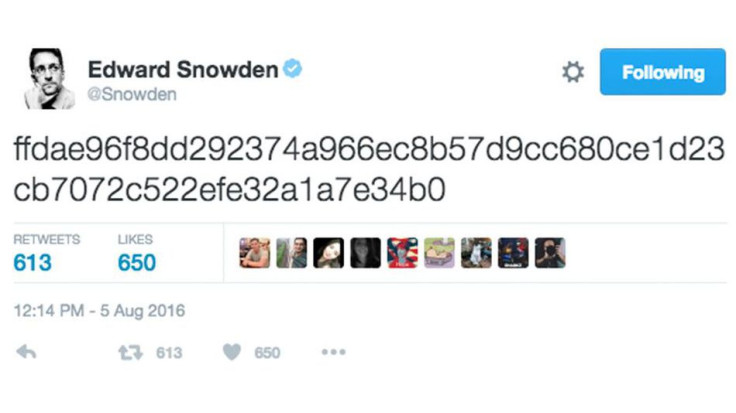Is Edward Snowden dead? Conspiracy theory claims whistleblower killed after cryptic tweet
Rumours of his demise have been denied by confidante Glenn Greenwald.
Exiled NSA whistleblower Edward Snowden sparked intrigue on 5 August after tweeting a 64-digit code to his two million-strong Twitter following, which conspiracy theorists quickly assumed meant he had met his untimely demise. The fears were sparked by a Russian news website called Sputnik, which reported the now-deleted tweet could have been a "dead man's switch" – an insurance code set up to aid the release of another trove of documentation "if he did not check in to the computer at a certain time."
However, the rumours of his death or kidnapping have been denied by Snowden's close confidante Glenn Greenwald, who replied to one concerned tweet with: "He's fine."
In any case, since the posting Snowden's own Twitter presence has been eerily muted.
Previously, Snowden has indicated he has such an insurance tactic in place should something happen to him while he is living under asylum in Russia.
In one report by Wired, published in 2013 after the initial NSA disclosures hit the headlines, Greenwald described the system in place. "It's really just a way to protect himself against extremely rogue behaviour on the part of the United States, by which I mean violent actions toward him, designed to end his life, and it's just a way to ensure that nobody feels incentivised to do that," he said.
In response to the code, which appears on the surface to be a form of hash, journalist Barton Gellman also took to social media to note the tweet had a "private meaning" and was not intended for the general audience. "Everyone requesting proof of life for me and @Snowden, take a deep breath. Some tweets have private meaning," he wrote on 6 August.
Based on this, it is likely the long code is a form of verification used to prove to a contact of Snowden that he is the legitimate sender or recipient of a communication. Using a direct mail to message, for example, would leave metadata, and therefore a record of the conversation taking place.

Gellman, who is currently writing a book about the Edward Snowden leaks, was previously embroiled in another recent post that sparked controversy after the former NSA contractor mysteriously tweeted: "It's time."
In one PGP-signed posting – quickly dispelling mounting conspiracy theories – Gellman elaborated: "I am digitally signing this message for people who like to be extra careful. After three years of writing about the NSA and Ed Snowden, I am one of those people too. I'm writing a book for Penguin Press called Dark Mirror: Edward Snowden and the American Surveillance State.
"I want to hear from anyone who has first-hand information on either. It need not be some deep dark secret. I'm interested in your observations about Snowden's work and work habits at CIA, Dell, NSA and Booz; or his time in the Army; or in computer training courses; or the surveillance programs and practices he described."

Three years ago, Snowden leaked a trove of documents that focussed on the surveillance apparatus used by spy agencies across the world – including the NSA, FBI and UK's Government Communications Headquarters (GCHQ).
In light of this, the use of a so-called dead man's switch was used to protect his wellbeing. Additionally, whistleblowing outfit WikiLeaks, which has released sensitive files from the US government, also uses the technique. Most recently, the group's founder, Julian Assange, uploaded a fresh 88GB file to the internet – just prior to the leaks from the Democratic National Committee (DNC).
© Copyright IBTimes 2025. All rights reserved.






















